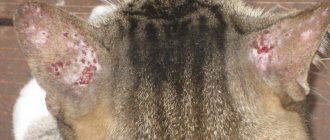Many pet owners are interested in whether fleas from a cat can spread to humans and how dangerous their bites are. It has been proven that such parasites are not capable of living on the human body, but can introduce any infection into the body through a bite, causing severe harm to health. Therefore, if your cat has fleas, you must get rid of them.
Cats have fleas.
Features of parasitism
Each animal has its own variety of fleas. And they settle only on a specific pet, feeling good there: the body temperature suits them, as well as the composition of the blood, the thickness of the coat.
But at the same time, insects normally tolerate negative conditions for them and can even starve for up to a month. Moreover, if another type of animal is nearby, they can use it for food and temporary shelter, as well as for movement. Fleas are very unpretentious “people”.
The "cat" type of flea is called Ctenocephalides Felis. This is literally translated from Latin as “cat flea”.
These are precisely the parasites that settle in the fur of domestic furry animals and begin to actively multiply there. It is worth remembering that “dog” fleas can easily spread to a cat if there are different pets living in your house.
Flea development cycle
Fleas in cats are transmitted to humans only as a last resort. But despite this, cat fleas can bite humans. That is why it is important to ensure that your pets’ fur is free of these parasites. Otherwise, all residents of the apartment will be bitten. The flea development cycle takes from two weeks to a month. Much depends on external conditions.
An adult insect emerges from the cocoon and looks for a victim in whose body it could settle. One flea is followed by others, resulting in numerous colonies. Up to two hundred fleas can parasitize a pet's body at the same time.
The optimal temperature for the development of fleas is 18-27 degrees Celsius with a humidity of 70-100%. In such favorable conditions, fleas will grow very quickly: 20-50 days. If the air importance is lower than mentioned above, then most of the larvae may not hatch, but die. Fleas are temporary parasites that use pets and humans to feed and avoid starvation.
How does the insect behave?
She spends a huge part of her life in landfills, in the grass, in the nests of birds and animals, she can live in basements, and loves dampness.
Pets are used only for food and reproduction. She jumps onto the animal’s body, bites it several times, drinks the blood, and after satiation returns to her “home.” Despite the unique ability to starve for a long time, fleas cannot develop and reproduce without food.
One flea can lay up to 500 eggs in its lifetime. These eggs are almost invisible, they are smooth and very small.
They accumulate in the bed where the cat rests, or remain in her fur. After 6–10 days, the first larvae appear and begin to feed in the same way as adults. At the same time, they also do not live on fur, but move to the dark corners of an apartment or house, where they develop, pupate and turn into adult fleas.
Preventing fleas
It is better to prevent the appearance of bloodsuckers than to fight them. Below are the main measures to prevent fleas.
- Use an insecticidal collar for cats or dogs. This will prevent bloodsuckers from appearing on the animals.
- Carry out regular inspection of cats (dogs) for the presence of fleas.
- Treat the area near the front door with a long-acting insecticide. Mashenka chalk is quite suitable for this. This prevention should be done because flea eggs can be carried on shoes.
- Regular cleaning of the apartment. Cat fleas love to live in carpets and in areas where there is trash or trash. This is where they lay eggs, so it is necessary to regularly vacuum the floor, carpets, furniture and do wet cleaning.
If fleas appear on domestic cats or dogs, you need to act immediately. Special anti-flea drops and shampoos will help here. It is advisable to eradicate parasites from a cat before they have time to “attack” its owner, because they are transmitted to humans very quickly. The apartment also needs to be treated with insecticides or call a pest control service that will get rid of pests for money without any extra hassle.
In order to save yourself and your beloved animal from the invasion of bloodsuckers, you must follow preventive measures. If this does not help, and cat fleas begin to parasitize the residents, you should immediately begin to destroy harmful insects. Then both the owner and his beloved pets will be calm and happy.
Are cat parasites transmitted to humans?
Many pet owners wonder whether cat parasites can spread to humans.
The cat flea is not very fond of human skin, although it bites when there is no other “victim” nearby.
It will not live or reproduce on the body, since the temperature in humans is lower than that needed by the insect for metabolism and normal existence. And the cat’s temperature is approximately 38–39 °C, which is very comfortable for a flea.
The difference in temperature is quite large, and we also have thicker skin than a pet. Thus, the question of whether parasites are transmitted from cats to humans can be answered in the negative.
But sometimes insects cause trouble: the bitten areas are very itchy.
What do cat fleas look like?
There are more than 2 thousand species of blood-sucking fleas, and one of the most common varieties is the cat parasite (ctenocephalides felis). They have a body flattened on the sides with spines and bristles that allow them to be held in the fur. The dimensions are miniature - an adult is about 2 mm in length, and in a well-fed state it can reach 4 mm. The color of the body is dark brown, with a slight gloss. Fleas do not have wings, but their very long hind legs allow them to make long jumps. An ordinary person is not able to identify the differences between cat fleas and dog, rat or other varieties; only an entomologist with special equipment can do this.
Cat fleas are very small in size - about 2 mm when hungry.
The piercing-sucking type of mouthparts is the main instrument for extracting blood necessary for the life support of the insect. Fleas need blood at all stages of their life cycle; even larvae feed on the feces of adult insects, which contain blood. Hungry individuals are not able to mate; without blood sucking, neither sexual development, nor reproduction, nor feeding of offspring is possible. One of the differences between fleas and other blood-sucking parasites is that during the bite they do not inject any anesthetic substances into their victim.
Can they live on the human body?
Fleas are blood-sucking insects. They settle on the animal’s body when they are hungry and begin to drink blood by sucking on the skin. However, it doesn’t matter to them whether it’s a person or a pet, they bite everyone the same way. It is believed that fleas cannot live on humans and bite them accidentally. But there is also a myth that fleas live in a cat’s fur and never leave their “house.” But is it?
In fact, flea larvae and even adults do not live permanently even on the body of an animal. They find a home not far from the place where the pet spends a lot of time. Most often this is bedding, carpet, soft bed, as well as furniture.
Fleas very often live in basements, and then begin to spread throughout the first floor. And if you don’t protect your pet in time by using preventive measures, then very soon fleas will begin to annoy him with bites.
From this we can conclude that not all types of such insects live in a pet’s fur. And even more so, they will not live on humans. The flea can remain in a fold of clothing for some time, but, having saturated itself with blood, it leaves its victim. There is nowhere to hide on the human body, since he does not have thick hair, so parasites will never choose it as a permanent habitat.
Main symptoms
Cat fleas can be transmitted to humans, so it is very important to promptly recognize a pet infestation and take action. At the first stage, the cat scratches itself only occasionally; in general, the animal’s behavior is no different from its usual one, so at this stage it is difficult to notice anything. Only an experienced owner can understand that something bad has happened to a pet.
At the second stage, symptoms already become obvious:
- the animal behaves restlessly;
- the pet constantly bites itself, trying to eliminate pests;
- the pet refuses to take food, its appetite worsens;
- the cat meows all the time, calling the owner for help;
- Your furry pet's sleep is getting worse.
At this stage, you can examine the parasites by parting the cat's fur. There are many scratches, bites, and bloody wounds on the animal’s body. As the disease progresses, the pet becomes nervous and restless, eats little and loses weight. His hair falls out and bald spots form. Allergic dermatitis may appear. In this case, you need to urgently save the animal.
Sometimes a large number of fleas can cause death. A kitten suffering from fleas often develops anemia.
Are these insects dangerous for the animal owner or not?
It is very important to know how dangerous fleas are for a pet owner who has become ill with parasites. Common bite marks are not harmless: they can have serious consequences:
- Allergy. Usually occurs in people who are prone to similar reactions and often suffer from various irritants. Allergic dermatitis appears on hypersensitive skin. In this case, the allergen is the flea's saliva, which will cause the bitten area to itch for a long time.
- Infection with worms. Parasites are carriers of nematodes, as well as helminths. As a result, dipilidia may develop, during which tapeworms begin to develop in the body. Their largest size in the intestine is 70 cm.
- Bartonellosis. This is a whole group of diseases that differ from each other, but the source of their occurrence is the same - bacteria carried by fleas. All of them pose a potential danger to humans.
All these diseases can be contracted not only at home if your pet catches fleas. But insects can also bite in the entrance, on the street, when interacting with street animals and even with pets.
Fleas can appear in an apartment very easily: you can bring them on shoes or clothes along with dirt.
It is also worth remembering that fleas are capable of giving rise to entire epidemics, which has already happened more than once: they are carriers of typhoid and plague. Therefore, we must not forget about prevention: check your pet as often as possible for the presence of these unpleasant and dangerous insects.
How to treat flea bites
Treatment of cat flea bites is usually symptomatic and involves the following procedures:
- wound disinfection. Even a microscopic puncture of the skin is a violation of its integrity, so the bite area is treated with an antiseptic. You can use whatever is at hand (hydrogen peroxide, iodine, alcohol, chlorhexidine, etc.);
- relieving itching and swelling. To do this, use special formulations designed for situations with insect bites, for example, Fenistil Gel, Psilo-Balm, etc. To combat swelling, you can apply a piece of ice wrapped in a cloth.
If after a flea attack there is a serious reaction with fever and general weakness, then you should immediately consult a doctor to prescribe the correct treatment.
Signs of bites
Flea bites are quite noticeable and unpleasant. It is very important to learn to recognize them in order to begin disinfection in time. After all, insects will not go away on their own: they multiply very quickly and begin to live in:
- cracks;
- carpets;
- sofas;
- bedding.
Here are some obvious signs that you have been bitten by a flea:
- At the moment of the bite, you will feel a prick on your skin, which is much more painful than a mosquito bite.
- Later, red dots may be seen on the skin. Sometimes the blisters swell and the skin around them turns red.
- The affected area is very itchy, causes a lot of trouble and constantly reminds you of itself.
- The bites are approximately 1–2 cm apart. But these are not straight paths, as happens if bedbugs live in the house.
- Insects usually bite legs, since their jumps do not exceed half a meter. But if they settled in the bed or jumped into it, they can bite the whole body.
Depending on the sensitivity of the skin and the characteristics of the human body, the marks after bites can be different: small, invisible or blurred, very large. But they will still disappear in a few days, so there is no need to be afraid.
Treatment
Treatment of the affected area is carried out in several stages:
- The wound is washed with warm soapy water.
- The bite site is treated with hydrogen peroxide or another antiseptic solution.
- Ice is applied (to avoid hematoma) or a cold compress is used. It should be changed every 20-25 minutes.
The greatest discomfort is caused by itching at the site of the bite. A weak soda solution or sulfur ointment will help you cope with it. You can treat the wound with iodine or brilliant green.
It is important! You should not scratch flea bites - there are more bacteria on your hands and under your nails. Their entry into the wound leads to suppuration and other complications.
If the rash and itching do not go away, symptoms characteristic of dermatitis, anthrax and other pathologies listed above appear, you should immediately call an ambulance or go to the nearest hospital. The earlier treatment is started, the higher the chances of recovery.
How to fight?
How to rid your pet of annoying parasites? There are several effective ways:
- Shampoo. You can buy a special shampoo that kills fleas. It contains insecticides that do not leave insects the slightest chance. The product is used as usual, which is used for regular washing: applied to the wool, foaming well with your hands. Then you need to wait a little for the composition to take effect and rinse off. Shampoos are good because they prevent relapses: fleas will not return in the near future.
- Collar. It is more of a preventive remedy that repels insects that want to feed on the animal’s blood. The disadvantage of using it is that the collar does not destroy fleas that already live on the cat.
- Drops. An inexpensive and effective remedy that allows you to get rid of parasites in a short time. The drug purchased at a veterinary pharmacy is dripped onto the withers or any other inaccessible place on the animal’s body so that it does not lick off the substance. Soon the substances spread throughout the epidermis, accumulate inside and have a detrimental effect on fleas.
- Spray. It has the same effect as drops. It differs in the method of application: the owner sprays the composition over the skin and fur of the animal. You need to make sure that the cat does not lick itself for a while until the spray dries. This product is also applicable to bedding, carpets, and household items in which cat fleas live.
Remember that by ridding an animal of parasites, you do not protect it from re-infection.
After all, very often fleas accumulate in an apartment, and wet cleaning only multiplies - they love high humidity. Even frost does not scare them. Therefore, after treating a flea-bearing cat, you need to take care of the apartment: disinfect it with special means. But many of them are toxic, so after the procedure it is advisable to leave for a while and take your pet with you.
Cat fleas do not live on humans, but they can cause a lot of trouble and trouble in the form of bites.
If you notice that your animal is itching frequently, examine it and take action if you find signs of flea bites. The sooner you do this, the easier it will be for you: removing a small number of parasites that have not yet had time to reproduce is not as difficult as using countermeasures for an entire nursery.
Don't forget about prevention - let your cat wear an anti-flea collar, and then the risk of becoming infected with parasites will be reduced to zero.
Causes of infection
Unfortunately, pets bring not only positive emotions, but also some troubles, such as parasites living in fur. In the absence of food sources, they are capable of moving onto people. Fleas are transmitted from cats to humans very often; when the first signs of infection appear, it is important to quickly respond and take action by choosing products that are safe for your pet.
Pests are distinguished by high endurance and the ability to quickly adapt to a new habitat. A cat can become infected with fleas in a variety of ways. Parasite larvae are resistant to unfavorable conditions. Young individuals can live without a host; they do not need blood at an early age.
The danger fleas pose to cats is described in the video:
A cat can become infected in the following ways:
- On a walk. All an animal needs to do is walk on the grass, lie down on a bench, or run on the sand: there are larvae everywhere.
- Fleas can be transmitted from cats to humans, and from humans to furry pets. If the owners visit and pet a flea-covered cat, the parasites can get on their clothes and shoes. This way the pests will move to another house. Larvae can be found not only on your pet’s fur, but also on any things. Therefore, when visiting, you should be careful.
- The mother can infect the kitten. From her, parasites can be transmitted to an entire brood. Experts advise treating your pet before lambing to prevent such a problem.
- Rodents are also carriers of insidious bloodsuckers. When a cat hunts, it can easily become infected with fleas from them.
Animals can become infected with parasites while walking or through contact with an infected animal.











